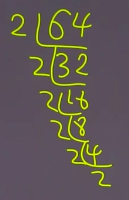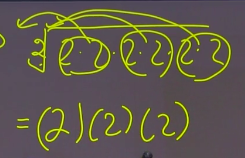Square and square roots
Topic Notes
Ex: =
=
To square root: Finding the two identical factors
Ex: = = 4
= = 7
Perfect squares numbers: = 0
= 1
= 4
= 9
= 16
= 25
= 36
= 49
= 64
= 81 & so on... {100, 121, 144, 169, 196...}
What is a square root?
To explain square roots, let's take a step back and remember what it means to square a number. To square is to raise the number to the second power. Square roots are the opposite of that, and is actually the inverse operation of squaring. To square root is to find the two identical factors of a number.
How to find the square root of a number
For numbers that are perfect squares, you can find whole numbers as answers. However, for numbers that aren't perfect squares, you'll have to use a method that involves estimation (or you can use a table of square and square roots).
Finding square root of perfect square numbers
Let's first take a look at this question here:

What is the square root of 64? If you have a calculator, you can always just punch in it and get the answer. But do you know how to find the square root of a number without a calculator?
Now, if you do remember your perfect squared numbers, the root of 64 is just eight. Eight times eight gives you 64. But let's say you can't freely recall perfect numbers. How would do we do this from scratch?
First, you will have to find all the prime factors of 64. So, let's go ahead and do that:

Imagine that the question now becomes 2x2x2x2x2x2— 2 is multiplied 6 times here. So we've just determined that 64 is just a square root of six 2s, all multiplied together.

Before we move on, we must remember that the radical sign actually means "the square root". The square root symbol should really be written with a tiny little two here:

Since it's a square root, you can pick a pair of identical numbers to work with and bring them out from under the radical. In this case, we'll take out a 2 from the first pair of 2s, another 2 from the second pair, and another 2 from the last pair. It should look something like this:

Now if you multiply the 2s with one another, what do you get? You'll find that you get 8, which is exactly the same as what you would have remember if you knew your perfect squares. However, this is the correct way to find the square root of a number without memorization.
Finding square root of numbers that aren't perfect squares
The basic method to find the square root of a number that is not a perfect square is as follows:
Estimate: Pick a number that if you square comes close to, but is less than, the square root of the number you're trying to find.
Divide: Divide the number that you are finding the squared root for with the number you picked in step 1
Average: Take the average of the number you got in step 2 and the square root
Repeat: Repeat steps 2 and 3 until the number is accurate enough for you
Now you've learned how to find the square root for numbers that both are and are not perfect squares. Continue on with our lessons to learn how to deal with different radical numbers examples.

